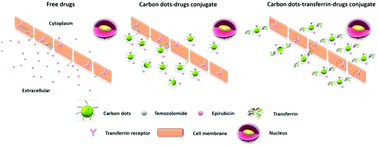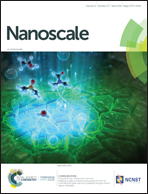Triple conjugated carbon dots as a nano-drug delivery model for glioblastoma brain tumors†
Abstract
Most of the dual nano drug delivery systems fail to enter malignant brain tumors due to a lack of proper targeting systems and the size increase of the nanoparticles after drug conjugation. Therefore, a triple conjugated system was developed with carbon dots (C-dots), which have an average particle size of 1.5–1.7 nm. C-dots were conjugated with transferrin (the targeted ligand) and two anti-cancer drugs, epirubicin and temozolomide, to build the triple conjugated system in which the average particle size was increased only up to 3.5 nm. In vitro studies were performed with glioblastoma brain tumor cell lines SJGBM2, CHLA266, CHLA200 (pediatric) and U87 (adult). The efficacy of the triple conjugated system (dual drug conjugation along with transferrin) was compared to those of dual conjugated systems (single drug conjugation along with transferrin), non-transferrin C-dots–drugs, and free drug combinations. Transferrin conjugated samples displayed the lowest cell viability even at a lower concentration. Among the transferrin conjugated samples, the triple conjugated system (C-dots-trans-temo-epi (C-DT)) was more strongly cytotoxic to brain tumor cell lines than dual conjugated systems (C-dots-trans-temo (C-TT) and C-dots-trans-epi (C-ET)). C-DT increased the cytotoxicity to 86% in SJGBM2 at 0.01 μM while C-ET and C-TT reduced it only to 33 and 8%, respectively. Not only did triple conjugated C-DT increase the cytotoxicity, but also the two-drug combination in C-DT displayed a synergistic effect.



 Please wait while we load your content...
Please wait while we load your content...